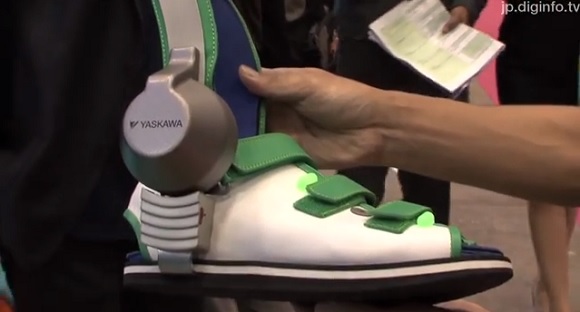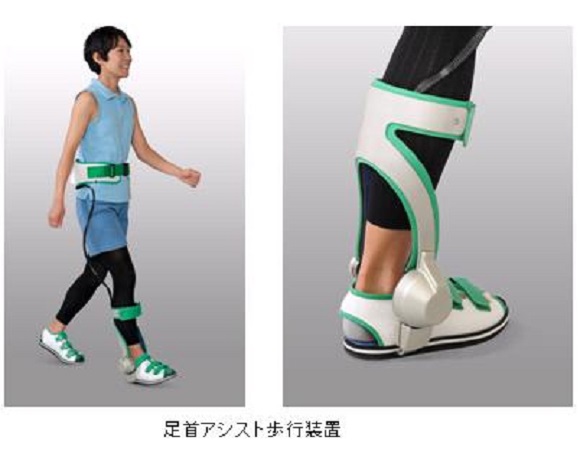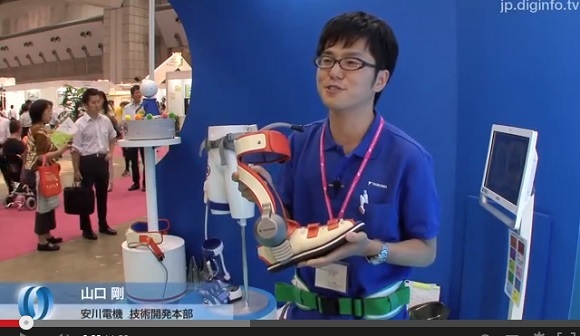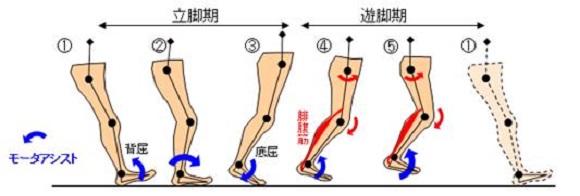
Japan is no stranger to robotics. From Asimov to Gundam, hi-tech development in both real and fictional worlds is almost taken for granted. Some days, we even wake up feeling a bit disappointed that Ghost in the Shell isn’t a documentary–though even that seemingly becoming closer to reality every day.
Here’s one example of robotics enhancing the lives of stroke victims–and looking good doing it, too!
Strokes are pretty scary–and they’re not limited to older folks either. While we certainly hope that none of us or our readers will suffer from a stroke any time soon, at least we can take comfort in knowing that work on post-stroke recovery is advancing one step at a time.
Yaskawa Electric, a company aiming to develop both robotics to help the elderly in countries with low birth rates and environmentally friendly energy resources, has debuted an “ankle-assist walking device.” The device, one part of their “2015 Vision,” uses sensors and electric motors to basically teach stroke victims and others with walking-impediments how walk again.
Relearning basic physical movements like walking can be very difficult for stroke-victims, according to Yaskawa, partially because of how hard it can be to verbally describe to a patient how to walk. After all, when we were learning to get up and waddle around, it wasn’t like our parents were telling us what to do, shouting “Shift your weight onto the ball of your foot! Now lift your heel and bend your knee!” And even if they were, we almost definitely weren’t listening to them!
▼Let’s be honest: These things are going to be the hottest fashion in about five years.
The therapeutic devices that Yaskawa has created use actuators to “show” patients in therapy how their feet should be moving by rotating the device up and down as they walk. This physical feedback provides an accurate feel for how their bodies are supposed to be moving, helping stroke-victims and others avoid further injuries and re-learn the movements that once came naturally. One problem stroke patients face is that many do not properly lift the tips of their toes, which results in tripping and falling. A fall for someone who’s already suffered a stroke or some other physical ailment is sure to compound the problem, so quick, correct rehabilitation is vital.
The devices can be strapped on around the patient’s ordinary shoes and clothes, allowing for quick and easy attachment. Additionally, the sensors in the bottom of the devices, which look like giant anime boots to us, can accurately detect if the wearer is walking correctly–ensuring a gait like the one shown below.
▼On the left is the “stance phase” and on the right is the “swing phase.”
Starting from the left, the patient is meant to be: 1) Putting their foot down, heel first, 2) laying their toes down, 3) raising their heels with their toes still on the ground, 4) lifting their toes up, 5) moving the entire leg forward and then back to the first step again.
The company currently has the device in a number of clinical trials where it seems to be showing promising results. Hopefully it works as expected and will soon be on the market helping speed up people’s recovery!
If you’re interested in learning more about Yaskawa Electric, who will be celebrating their 100th anniversary in 2015, be sure to check out their English homepage.
Sources: Yaskawa Electric, DigInfo TV
Images: Yaskawa Electric
You can check out a video demonstration of the device below. The explanation is in Japanese, though still it gives you an idea of how they work in practice.




 JINS MEME: Award winning glasses track your physical state and concentration levels
JINS MEME: Award winning glasses track your physical state and concentration levels Japan’s ‘agri-tech’ farming revolution
Japan’s ‘agri-tech’ farming revolution “What’s wrong with her eyes!?” Say hello to the dentist’s doll from the (past, present) future
“What’s wrong with her eyes!?” Say hello to the dentist’s doll from the (past, present) future Real-life Iron Man? Partially paralyzed Indonesian welder claims to have built bionic arm【Video】
Real-life Iron Man? Partially paralyzed Indonesian welder claims to have built bionic arm【Video】 Tokyo clinic’s Cinderella Breast Augmentation will boost your bust, but only for a single day
Tokyo clinic’s Cinderella Breast Augmentation will boost your bust, but only for a single day Kyoto Whopper divides customers at Burger King Japan
Kyoto Whopper divides customers at Burger King Japan Taking the Kyoto overnight bus for the first time
Taking the Kyoto overnight bus for the first time Forbidden area at Japanese mountaintop shrine opens to the public for first time in 400 years
Forbidden area at Japanese mountaintop shrine opens to the public for first time in 400 years Japan reaches its lowest-ever ranking on Education First’s 2024 English Proficiency Index
Japan reaches its lowest-ever ranking on Education First’s 2024 English Proficiency Index Japanese burger chain no longer serves onion rings, but offers intriguing replacement【Taste test】
Japanese burger chain no longer serves onion rings, but offers intriguing replacement【Taste test】 Krispy Kreme releases new zodiac doughnuts for the Year of the Snake in Japan
Krispy Kreme releases new zodiac doughnuts for the Year of the Snake in Japan Children’s slippers stolen in night at Japanese preschool, police identify weasel who did it【Vid】
Children’s slippers stolen in night at Japanese preschool, police identify weasel who did it【Vid】 Ghibli’s Princess Mononoke teams up with Foxfire for outdoor apparel collaboration【Photos】
Ghibli’s Princess Mononoke teams up with Foxfire for outdoor apparel collaboration【Photos】 Starbucks Japan unveils second Holiday Frappuccino for 2024
Starbucks Japan unveils second Holiday Frappuccino for 2024 New card game makes Japan’s saunas even steamier
New card game makes Japan’s saunas even steamier One of Japan’s most beautiful hot spring towns announces new limits on number of day trippers
One of Japan’s most beautiful hot spring towns announces new limits on number of day trippers Berserk T-shirts coming to Uniqlo for launch of new Manga Curation line【Photos】
Berserk T-shirts coming to Uniqlo for launch of new Manga Curation line【Photos】 Mario Kart Happy Meal toys arrive at McDonald’s Japan, and SoraNews24 has the whole set!【Photos】
Mario Kart Happy Meal toys arrive at McDonald’s Japan, and SoraNews24 has the whole set!【Photos】 After cancelling Halloween, Tokyo’s Shibuya neighborhood cancels New Year’s Eve too
After cancelling Halloween, Tokyo’s Shibuya neighborhood cancels New Year’s Eve too Tokyo park’s sea of clouds, nighttime illumination, and cosplay days make now perfect time to visit
Tokyo park’s sea of clouds, nighttime illumination, and cosplay days make now perfect time to visit Samurai ritual suicide contest cancelled by organizer in west Japan
Samurai ritual suicide contest cancelled by organizer in west Japan Japanese job-quitting service contacted by other job-quitting service because employee wants to quit
Japanese job-quitting service contacted by other job-quitting service because employee wants to quit Flying dango: Unique tourist site where Japanese sweets are flown to you over a gorge
Flying dango: Unique tourist site where Japanese sweets are flown to you over a gorge American jackass tourist arrested after carving name into gate at Tokyo’s Meiji Shrine【Video】
American jackass tourist arrested after carving name into gate at Tokyo’s Meiji Shrine【Video】 Nintendo’s controller capsule toys are so cool, even the machine you buy them from is awesome【Pics】
Nintendo’s controller capsule toys are so cool, even the machine you buy them from is awesome【Pics】 Tokyo Disneyland loses top-attendance crown for Japanese theme parks for second year in a row
Tokyo Disneyland loses top-attendance crown for Japanese theme parks for second year in a row Ghibli Park debuts first winter illumination display with Howl’s Moving Castle theme
Ghibli Park debuts first winter illumination display with Howl’s Moving Castle theme Pringles releases a limited-edition sweet flavour in Japan
Pringles releases a limited-edition sweet flavour in Japan Sanrio and magical girl anime PreCure join forces for new merch line【Photos】
Sanrio and magical girl anime PreCure join forces for new merch line【Photos】 What’s the deal with akebi, the perfectly purple, alien-like fruit that’s in season now in Japan?
What’s the deal with akebi, the perfectly purple, alien-like fruit that’s in season now in Japan? McDonald’s new Happy Meals offer up cute and practical Sanrio lifestyle goods
McDonald’s new Happy Meals offer up cute and practical Sanrio lifestyle goods Foreign tourists on Shinkansen bullet train break suitcase etiquette, angering local passengers
Foreign tourists on Shinkansen bullet train break suitcase etiquette, angering local passengers [Deleted] Article written for April Fool’s Day 2018
[Deleted] Article written for April Fool’s Day 2018 Japanese government to make first change to romanization spelling rules since the 1950s
Japanese government to make first change to romanization spelling rules since the 1950s Foreigner’s request for help in Tokyo makes us sad for the state of society
Foreigner’s request for help in Tokyo makes us sad for the state of society Ghibli founders Toshio Suzuki and Hayao Miyazaki contribute to Japanese whisky Totoro label design
Ghibli founders Toshio Suzuki and Hayao Miyazaki contribute to Japanese whisky Totoro label design Japanese convenience store Family Mart announces abolishment of eat-in spaces
Japanese convenience store Family Mart announces abolishment of eat-in spaces Princesses, fruits, and blacksmiths: Study reveals the 30 most unusual family names in Japan
Princesses, fruits, and blacksmiths: Study reveals the 30 most unusual family names in Japan Life-size vibrating Legend of Zelda Master Sword for sale from Nintendo【Photos】
Life-size vibrating Legend of Zelda Master Sword for sale from Nintendo【Photos】 Studio Ghibli releases free-download board game — Here’s how to play it without reading Japanese
Studio Ghibli releases free-download board game — Here’s how to play it without reading Japanese Metal Gear Solid’s composer wants you to chill
Metal Gear Solid’s composer wants you to chill South Korean shipyard workers wear robo-suits for super-strength
South Korean shipyard workers wear robo-suits for super-strength There’s now a moving Gundam anime robot model that you can control with your brain【Video】
There’s now a moving Gundam anime robot model that you can control with your brain【Video】 Honda has created a GPS navigation system for your shoes【Video】
Honda has created a GPS navigation system for your shoes【Video】 A cute robot will make you a perfect ice cream cone for 100 yen in Japan【Video】
A cute robot will make you a perfect ice cream cone for 100 yen in Japan【Video】 Amazing tool fixes ingrown nails, looks like a torture device
Amazing tool fixes ingrown nails, looks like a torture device New wearable device reads your pet’s mind (to remind you they’re probably annoyed at you)
New wearable device reads your pet’s mind (to remind you they’re probably annoyed at you) Father arrested for taking the fall for son’s hit and run in Tokyo
Father arrested for taking the fall for son’s hit and run in Tokyo Is smartphone pinky the new text claw? Overuse of mobile devices found to cause finger deformity
Is smartphone pinky the new text claw? Overuse of mobile devices found to cause finger deformity Panasonic develops data communication using an ordinary light and smartphone
Panasonic develops data communication using an ordinary light and smartphone Japanese writing system gets turned into handsome anime men with Hiragana Boys video game
Japanese writing system gets turned into handsome anime men with Hiragana Boys video game Japanese researcher develops glasses to replace eye contact, turn you into emotional cyborg
Japanese researcher develops glasses to replace eye contact, turn you into emotional cyborg Immersive Museum offers impressive impressionist fun this summer in Tokyo
Immersive Museum offers impressive impressionist fun this summer in Tokyo Want to make music, but can’t play an instrument? Casio app turns your hums into full tracks!
Want to make music, but can’t play an instrument? Casio app turns your hums into full tracks! Spiral escalators may be even more stylish than clothes at Japanese department store in Shanghai
Spiral escalators may be even more stylish than clothes at Japanese department store in Shanghai
Leave a Reply